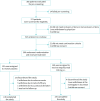Efficacy and safety of mepolizumab in a Chinese population with severe asthma: a phase III, randomised, double-blind, placebo-controlled trial
- PMID: 38770009
- PMCID: PMC11103715
- DOI: 10.1183/23120541.00750-2023
Efficacy and safety of mepolizumab in a Chinese population with severe asthma: a phase III, randomised, double-blind, placebo-controlled trial
Abstract
Background: In China, the prevalence of severe asthma with eosinophilic phenotype is rising, yet treatment options are limited. Mepolizumab is the first targeted biologic therapy for eosinophilic-driven disease in China. This study (clinicaltrials.gov identifier NCT03562195) evaluated efficacy and safety of mepolizumab in Chinese patients with severe asthma.
Methods: The phase III, multicentre, randomised, placebo-controlled, double-blind, parallel-group study enrolled patients aged ≥12 years with severe asthma, with two or more exacerbations in the previous year, and on inhaled corticosteroids plus at least one controller medication. Following a 1-4-week run-in, patients were randomised 1:1 to mepolizumab 100 mg or placebo subcutaneously every 4 weeks for 52 weeks. The primary end-point was annualised rate of clinically significant exacerbations (CSEs) through week 52. Secondary end-points were time to first CSE, frequency of CSEs requiring hospitalisation/emergency department visits or hospitalisation over 52 weeks, mean change in St George's Respiratory Questionnaire (SGRQ) total score and pre-bronchodilator forced expiratory volume in 1 s (FEV1) at week 52; safety was evaluated.
Results: The modified intention-to-treat population included 300 patients. At week 52 with mepolizumab versus placebo, annualised rate of CSEs was 65% lower (0.45 versus 1.31 events per year; rate ratio 0.35, 95% CI 0.24-0.50; p<0.001); time to first CSE longer (hazard ratio 0.38, 95% CI 0.26-0.56; p<0.001) and number of CSEs requiring hospitalisation/emergency department visit lower (rate ratio 0.30, 95% CI 0.12-0.77; p=0.012). From baseline to week 52, SGRQ score improved (p=0.001) and pre-bronchodilator FEV1 increased (p=0.006). Incidence of adverse events was similar between treatment groups.
Conclusion: Mepolizumab provided clinical benefits to patients with severe asthma in China and showed a favourable benefit-risk profile.
Copyright ©The authors 2024.
Conflict of interest statement
Conflict of interest: R. Chen, L. Wei, Y. Dai, Z. Wang, D. Yang, M. Jin and N. Zhong have no relevant conflicts of interest; T. Li was a permanent GSK employee at time of study; C. Xiong, S. Hu, J. Song, S. Kumar and R. Chan are permanent GSK employees and hold GSK shares; and A. Abdelkarim is a permanent GSK employee.
Figures



Similar articles
-
Efficacy of mepolizumab add-on therapy on health-related quality of life and markers of asthma control in severe eosinophilic asthma (MUSCA): a randomised, double-blind, placebo-controlled, parallel-group, multicentre, phase 3b trial.Lancet Respir Med. 2017 May;5(5):390-400. doi: 10.1016/S2213-2600(17)30125-X. Epub 2017 Apr 5. Lancet Respir Med. 2017. PMID: 28395936 Clinical Trial.
-
Efficacy and safety of once-daily single-inhaler triple therapy (FF/UMEC/VI) versus FF/VI in patients with inadequately controlled asthma (CAPTAIN): a double-blind, randomised, phase 3A trial.Lancet Respir Med. 2021 Jan;9(1):69-84. doi: 10.1016/S2213-2600(20)30389-1. Epub 2020 Sep 9. Lancet Respir Med. 2021. PMID: 32918892 Clinical Trial.
-
Mepolizumab treatment in patients with severe eosinophilic asthma.N Engl J Med. 2014 Sep 25;371(13):1198-207. doi: 10.1056/NEJMoa1403290. Epub 2014 Sep 8. N Engl J Med. 2014. PMID: 25199059 Clinical Trial.
-
Impact of baseline clinical asthma characteristics on the response to mepolizumab: a post hoc meta-analysis of two Phase III trials.Respir Res. 2021 Jun 22;22(1):184. doi: 10.1186/s12931-021-01767-z. Respir Res. 2021. PMID: 34158028 Free PMC article. Review.
-
Mepolizumab improves clinical outcomes in patients with severe asthma and comorbid conditions.Respir Res. 2021 Jun 7;22(1):171. doi: 10.1186/s12931-021-01746-4. Respir Res. 2021. PMID: 34098955 Free PMC article. Review.
Cited by
-
Mepolizumab in Severe Pediatric Asthma: Certainties and Doubts through a Single-Center Experience and Review of the Literature.Children (Basel). 2024 Jul 25;11(8):895. doi: 10.3390/children11080895. Children (Basel). 2024. PMID: 39201830 Free PMC article.
-
The management of type 2 inflammatory respiratory diseases: a Chinese expert consensus [2024].J Thorac Dis. 2025 Apr 30;17(4):1807-1831. doi: 10.21037/jtd-2024-2092. Epub 2025 Mar 25. J Thorac Dis. 2025. PMID: 40400979 Free PMC article. Review.
-
Clinical Remission Outcome in Chinese Patients With Severe Asthma With an Eosinophilic Phenotype Receiving Mepolizumab: A Post-hoc Analysis of a Phase 3, Randomized, Double-Blind, Placebo-Controlled Trial.Allergy Asthma Immunol Res. 2025 Jul;17(4):473-485. doi: 10.4168/aair.2025.17.4.473. Allergy Asthma Immunol Res. 2025. PMID: 40736776 Free PMC article.
References
-
- Global Iniative for Asthma (GINA) . Global Strategy for Asthma Management and Prevention. 2022. Available from: http://ginasthma.org/.
-
- Association Group of Chinese Thoracic Society . Guidelines for prevention and treatment of bronchial asthma (2020 edition). Chin J Tuberc Respir Dis 2020; 43: 1023–1048. - PubMed
Associated data
LinkOut - more resources
Full Text Sources
Medical
